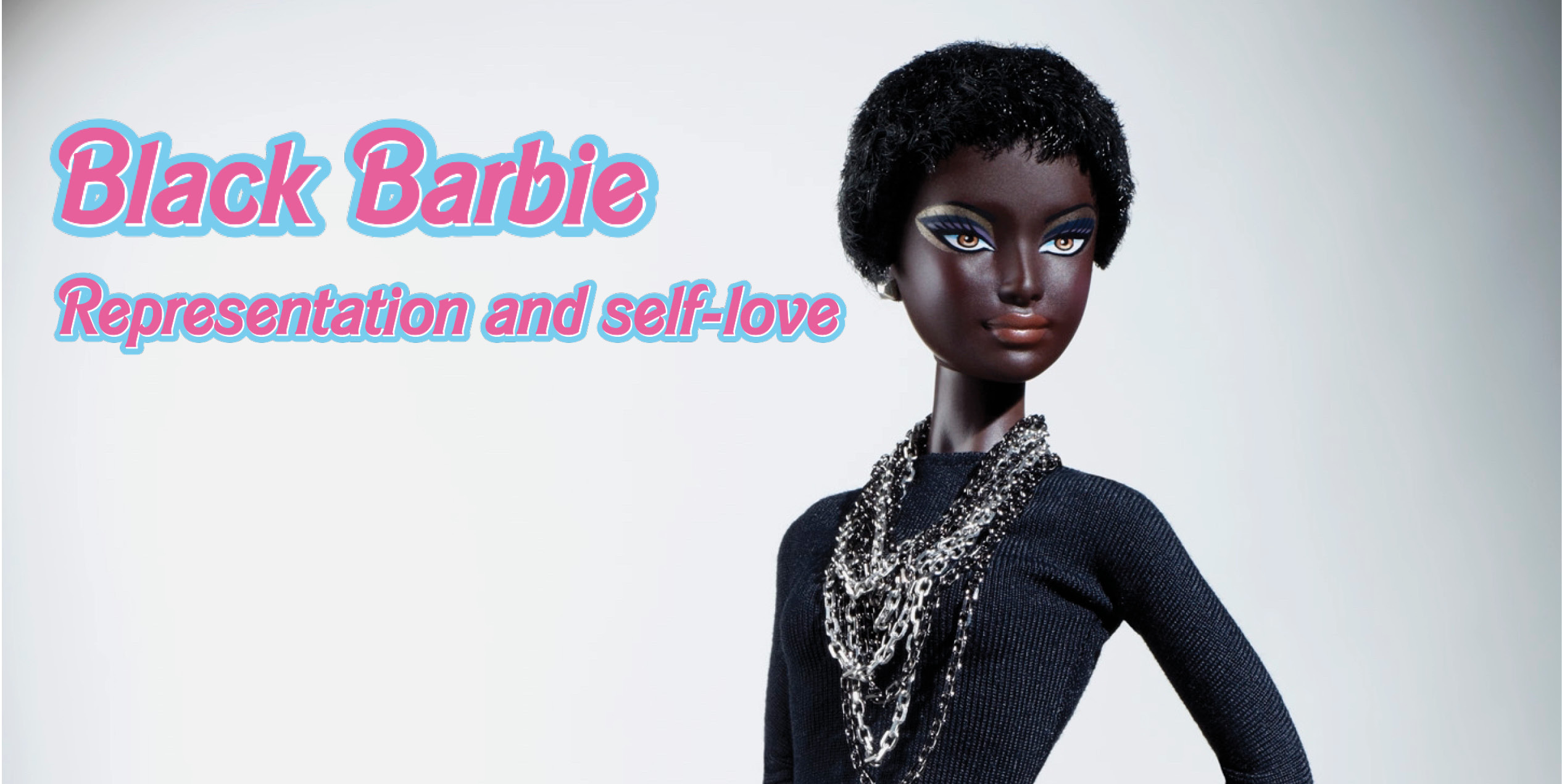
Aliyah Martinez is obtaining her MA in Fashion Studies at Parsons School of Design, The New School. She is interested in fashion as it reflects the identity and culture of marginalized groups. As her career continues, Aliyah will further highlight marginalized groups and their contributions.
As the opening scene of the Barbie movie narrates, for years, young girls were taught to play with baby dolls. Embodying nurturing, service, and mothering, this type of play evidenced the peak aspirations young girls were taught to have and the ideal of what womanhood meant. With the release of Barbie, who was instead in the figure of an adult woman, Mattel revolutionized the children’s toy market, and with it, began to build new ideals of womanhood. Barbie dolls would soon become household favorites with young girls worldwide, inspiring fantasies to help them identify and understand what it means to be of the world and where to leave their mark.
The history of Black girls and dolls is entirely more complex. Black girls navigate intersectional identities, faced with racial discrimination and misogyny simultaneously and often subconsciously. The oft-cited “doll test,” conducted in the 1940s and in which both Black and White girls professed to prefer White dolls, provides an example of how dolls exist at a nexus of the subconscious cultural messaging faced by Black girls. [1] The appearance of Black Barbies encouraged young Black girls to find beauty in a representation of themselves through play.
The history of Black girls and dolls is entirely more complex. Black girls navigate intersectional identities, faced with racial discrimination and misogyny simultaneously and often subconsciously. The oft-cited “doll test,” conducted in the 1940s and in which both Black and White girls professed to prefer White dolls, provides an example of how dolls exist at a nexus of the subconscious cultural messaging faced by Black girls. [1] The appearance of Black Barbies encouraged young Black girls to find beauty in a representation of themselves through play.
 Photo of Barbie birthday courtesy of the author.
Photo of Barbie birthday courtesy of the author.“Unlike the previous characters who had been introduced as Barbie’s friends, Black Barbie was Barbie, too.”
Race, as Americans conceptualize it today, is a legacy of the cultural divisions established during the eighteenth and nineteenth centuries. Traits such as skin color, facial features, and hair textures were used to classify human differences under the guise of a binary racial system (i.e., White or Black.) [2] The usage of these classifications justified laws and societal norms that preserved acts of discrimination and racism. The way society behaved as a result of human differences directly impacted the way marginalized individuals perceived themselves as well as enacted agency. The media in the American market commodified dangerous caricatures geared towards the Black population, which further complicated the relationship Black people had with their genetic markers. It is this conscious awareness that propelled generations of Black women to become intentional with their children’s exposure to the material culture geared toward Black children. As a child, my mother was deeply intentional in her decision to surround my sister and me with various Black Barbies. The subconscious power of the dolls’ representation manifested in the way I viewed my skin tone. I felt comfortable within my skin and found pride in my appearance. Many Black mothers, like mine, essentially wanted to curate a space that empowered their daughters’ differences.
Mattel’s historical releases of their Black Barbie dolls mark cultural shifts in how popular dolls have shaped the way both Black and non-Black children began to confront representations of race and ethnicity. As a first attempt to diversify their doll collection, a Black version of Barbie’s European cousin “Francie” debuted in 1967. Labeled “Colored Francie,” the indeed darker version of the doll was fashionable and racially distinct from the famously Eurocentric dolls that had come before. Both versions of Francie wore the mod-style aesthetic, a sub-youth culture in 1960s London known for their tailored clothing. Although this was a step in a new direction, the Black version of Francie faced much controversy as the only distinction between the two was the change in the mold’s skin tone. “Colored Francie” had the same facial features, flipped hair, and clothes as the other Francie. The Black American market did not receive the doll well.
The rejection of the “Colored Francie” doll was due to its failing to reflect Black American ethnic identification. In cultural studies, the term belonging-in-difference refers to the process of individuals navigating and negotiating belonging and differentiating themselves in communities. To imagine and belong to a community involves differentiating yourself from another community. [3] Although race can often be treated as synonymous with ethnicity, it is ethnicity that “enables people to think through how (and with whom) they experience a sense of identity and belonging.” [4] According to Stuart Hall, ethnicity is a reflection of the way people articulate their identities and communities, which involves a higher degree of self-agency. The power of self-agency is reflected through the styling practices that directly respond to the external conflict placed on the Black body. A black plastic doll in the mass American market needed to, therefore, reflect the articulations Black Americans were navigating aesthetically.
Mattel’s historical releases of their Black Barbie dolls mark cultural shifts in how popular dolls have shaped the way both Black and non-Black children began to confront representations of race and ethnicity. As a first attempt to diversify their doll collection, a Black version of Barbie’s European cousin “Francie” debuted in 1967. Labeled “Colored Francie,” the indeed darker version of the doll was fashionable and racially distinct from the famously Eurocentric dolls that had come before. Both versions of Francie wore the mod-style aesthetic, a sub-youth culture in 1960s London known for their tailored clothing. Although this was a step in a new direction, the Black version of Francie faced much controversy as the only distinction between the two was the change in the mold’s skin tone. “Colored Francie” had the same facial features, flipped hair, and clothes as the other Francie. The Black American market did not receive the doll well.
The rejection of the “Colored Francie” doll was due to its failing to reflect Black American ethnic identification. In cultural studies, the term belonging-in-difference refers to the process of individuals navigating and negotiating belonging and differentiating themselves in communities. To imagine and belong to a community involves differentiating yourself from another community. [3] Although race can often be treated as synonymous with ethnicity, it is ethnicity that “enables people to think through how (and with whom) they experience a sense of identity and belonging.” [4] According to Stuart Hall, ethnicity is a reflection of the way people articulate their identities and communities, which involves a higher degree of self-agency. The power of self-agency is reflected through the styling practices that directly respond to the external conflict placed on the Black body. A black plastic doll in the mass American market needed to, therefore, reflect the articulations Black Americans were navigating aesthetically.
After a first, and much-needed, success of the Julia doll, in honor of Diahann Carroll’s sitcom Julia, Mattel introduced the Christie doll, released in 1968, which addressed the failures of the Black version of Francie. Barbie’s new friend had her own identity with a different mold, creating new facial features, darker skin color, and short straight hair that mimicked the traditional press and curl popularized among Black American women and girls of the time. Variations of Christie existed in the market until the early 2000s. When young Black women today refer to the Black Barbie dolls of their childhood, Christie is often the doll they remember, whether the actual doll itself to her coordinating bed sheets and cake decorations. I believe that Christie marked a dynamic shift in young Black children’s affinity for their features once deemed inferior.
A new era arose in 1980 with the release of Black Barbie. Unlike the previous characters who had been introduced as Barbie’s friend, Black Barbie was Barbie too. Designed by Kitty Black Perkins, Black Barbie represented the ethnic re-articulations that expressed Black American identity. Reading the box, one finds a carefully written slogan: “She’s black! She’s beautiful! She’s dynamite!” The eyes will then land on a fashionable Black Barbie wearing a red gown, golden hoop earrings, a gold necklace, and matching red heels. What really marks this doll as revolutionary compared to Mattel’s previous Black dolls was her Afro. The hairstyle synonymous with Black pride and resistance had slowly lost its reign by the 1980s. Despite this, Black Perkins’s intentionality to use the Afro spoke to the Black parents and children of the American market that this Barbie was culturally sound and embodied Black pride in our racialized looks.
A new era arose in 1980 with the release of Black Barbie. Unlike the previous characters who had been introduced as Barbie’s friend, Black Barbie was Barbie too. Designed by Kitty Black Perkins, Black Barbie represented the ethnic re-articulations that expressed Black American identity. Reading the box, one finds a carefully written slogan: “She’s black! She’s beautiful! She’s dynamite!” The eyes will then land on a fashionable Black Barbie wearing a red gown, golden hoop earrings, a gold necklace, and matching red heels. What really marks this doll as revolutionary compared to Mattel’s previous Black dolls was her Afro. The hairstyle synonymous with Black pride and resistance had slowly lost its reign by the 1980s. Despite this, Black Perkins’s intentionality to use the Afro spoke to the Black parents and children of the American market that this Barbie was culturally sound and embodied Black pride in our racialized looks.
The popularity of Black Barbie helped counter historical prejudice and discrimination of the Black diaspora. Many Black women, like Kitty Black Perkins, further actualized the importance of material culture in shaping the foundational understanding of race and beauty within the impressionable minds of young girls. The creation of Black Barbie helped shift ideals about features subconsciously deemed inferior into higher acclaim and esteem. Now, as a Black President Barbie, played by Issa Rae, enters her last scene in the Barbie movie in a red Adidas tracksuit with a gold Cuban-link chain after helping undo the wrongs of the Kens, young Black girls have another dream to aspire to. At the same time, they continue to build their self-identity in a society rooted in Eurocentric beauty. Even though my inner child’s heart was filled with excitement while viewing the film, the adult in me today recognizes that it will take much more than a doll to fight against the plight of both discrimination and society’s legacy of anti-Blackness.
Notes: Black Barbie
[1] “Brown v. Board: The Significance of the ‘Doll Test,’” In NAACP Legal Defense and Educational Fund, last accessed October 29, 2023. https://www.naacpldf.org/brown-vs-board/significance-doll-test/
[2] Susan B Kaiser and Denise Nicole Green, “Racial Rearticulations and Ethnicities,” in Fashion and Cultural Studies (2nd Ed), ed. by Susan B. Kaiser and Denise Nicole Green (London & New York: Bloomsbury, 2021), 77.
[3] Kaiser and Green, “Racial Rearticulations,” 76.
[4] Ibid.
Notes: Black Barbie
[1] “Brown v. Board: The Significance of the ‘Doll Test,’” In NAACP Legal Defense and Educational Fund, last accessed October 29, 2023. https://www.naacpldf.org/brown-vs-board/significance-doll-test/
[2] Susan B Kaiser and Denise Nicole Green, “Racial Rearticulations and Ethnicities,” in Fashion and Cultural Studies (2nd Ed), ed. by Susan B. Kaiser and Denise Nicole Green (London & New York: Bloomsbury, 2021), 77.
[3] Kaiser and Green, “Racial Rearticulations,” 76.
[4] Ibid.
Issue 15 ︎︎︎
Fashion & Southeast Asia
Issue 14 ︎︎︎
Barbie
Issue 13 ︎︎︎ Fashion & Politics
Issue 13 ︎︎︎ Fashion & Politics

